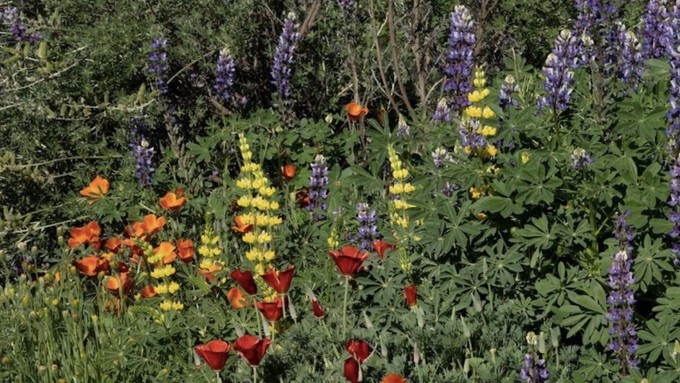
Visit a garden of natives as the green season gets going

Early spring 2022 was full of bright blooms at Patricia Carpenter's property. Photo by Beth Savidge, courtesy Patricia Carpenter
Yes, it’s almost spring, which means Patricia Carpenter, a California Native Plant Society Garden Ambassador, will be opening her Yolo County property Sunday, March 26, for the Early Spring Ramble in a Native Plant Garden.
“So much rain and wind and cold this past winter!” she said in the announcement of the event. “But spring is finally here – I think. How is the native garden responding? I invite you to come take a look.”
Expect to see wildflowers, Ribes and Ceanothus in bloom, and other signs of the native garden waking up. The 1-acre garden west of Davis (west of Pierce Ranch Road south of Russell Boulevard) will be open rain or shine from 10 a.m. to 3 p.m. for self-guided tours; visitors may start any time during those hours.
Maps will be available for use on site. Carpenter’s non-native garden will be open to view as well.
She will give brief orientation talks at 11 a.m. and 1 p.m.
Admission is free but registration is required. The registration link and more information can be found here.
Visitors should note that sturdy shoes are advised. No dogs, please. Anyone is welcome to bring a lunch or snack. A composting toilet is available onsite.
Gardeners inspired to plant natives will be able to shop from the Miridae Mobile Nursery truck, which also will be on site. Check out their latest inventory here.
In 2021 Carpenter and Pat Dressendorfer wrote an article for Pacific Horticulture about her garden in early spring. It can be found at https://pacifichorticulture.org/articles/the-native-plant-garden-in-early-spring/
Comments
0 comments have been posted.Sacramento Digs Gardening to your inbox.
Sites We Like
Garden Checklist for week of July 21
Your garden needs you!
* Keep your vegetable garden watered, mulched and weeded. Water before 8 a.m. to reduce the chance of fungal infection and to conserve moisture.
* Feed vegetable plants bone meal, rock phosphate or other fertilizers high in phosphate to stimulate more blooms and fruiting. (But wait until daily high temperatures drop out of the 100s.)
* Don’t let tomatoes wilt or dry out completely. Give tomatoes a deep watering two to three times a week.
* Harvest vegetables promptly to encourage plants to produce more. Squash especially tends to grow rapidly in hot weather. Keep an eye on zucchini.
* Pinch back chrysanthemums for bushy plants and more flowers in September.
* Remove spent flowers from roses, daylilies and other bloomers as they finish flowering.
* Pinch off blooms from basil so the plant will grow more leaves.
* Cut back lavender after flowering to promote a second bloom.
* It's not too late to add a splash of color. Plant petunias, snapdragons, zinnias and marigolds.
* From seed, plant corn, pumpkins, radishes, winter squash and sunflowers.